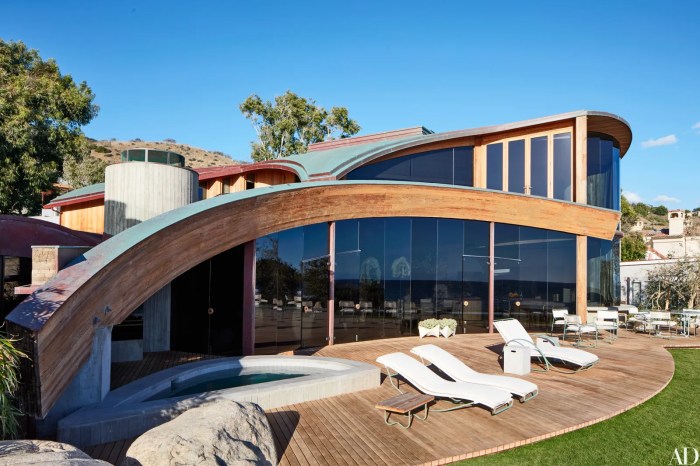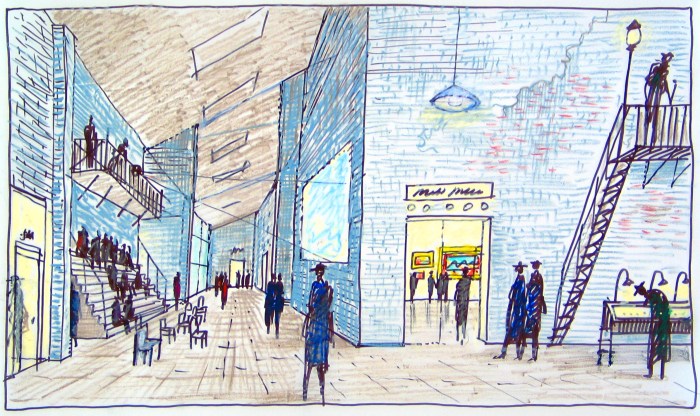Lautner House Design Elements That Inspire Builders
Beginning with Lautner House Design Elements That Inspire Builders, the narrative unfolds in a compelling and distinctive manner, drawing readers into a story that promises to be both engaging and uniquely memorable.
This article delves into the architectural marvel that is Lautner House, exploring its key design elements that have inspired builders and architects alike.
Lautner House Design Elements
The Lautner House, designed by renowned architect John Lautner, is characterized by several key architectural features that set it apart.
Key Architectural Features
- The use of geometric shapes and angles, such as triangular roofs and circular rooms, creates a unique and futuristic look.
- Large floor-to-ceiling windows allow for an abundance of natural light and blur the lines between indoor and outdoor spaces.
- Cantilevered roofs and walls give the impression of floating, adding to the sense of innovation and modernity in the design.
Use of Natural Materials
The Lautner House design incorporates natural materials such as wood, stone, and glass to create a harmonious relationship with the surrounding environment.
Integration with Surrounding Environment
- The use of floor-to-ceiling windows not only brings in natural light but also provides panoramic views of the surrounding landscape, seamlessly integrating the house with its environment.
- The choice of materials like wood and stone helps the Lautner House blend in with the natural surroundings, creating a sense of unity with nature.
- The innovative design elements, such as cantilevered roofs and open floor plans, allow for a fluid connection between the indoor and outdoor spaces, enhancing the overall integration with the environment.
Innovative Building Techniques
When it comes to innovative building techniques, the Lautner House stands out for its unique approach to construction. By combining advanced methods with creative design elements, the house achieves a remarkable blend of form and function.
Structural Integrity Through Design Elements
One of the key aspects of Lautner House's innovative construction is how it achieves structural integrity through its design elements. The use of cantilevered roofs, concrete walls, and steel beams not only create a visually striking aesthetic but also ensure stability and durability.
- The cantilevered roofs not only provide shade and protection but also distribute weight evenly, reducing the need for additional support structures.
- The concrete walls act as both a design feature and a structural element, offering stability and insulation.
- The steel beams used throughout the house add a modern touch while providing crucial support for the overall structure.
Challenges and Solutions in Implementation
Implementing Lautner's unique design ideas posed several challenges that required innovative solutions to overcome. From sourcing materials to ensuring precise construction, each step of the process presented its own set of obstacles.
- Challenge: Finding materials that could meet the specific design requirements and structural needs of the house.
- Solution: Collaborating with specialized suppliers and craftsmen to create custom components tailored to Lautner's vision.
- Challenge: Balancing the intricate design details with the practical aspects of construction to ensure both aesthetics and functionality.
- Solution: Working closely with architects, engineers, and builders to develop a comprehensive plan that addressed all aspects of the project.
Interior Design Concepts

When it comes to the interior design of the Lautner House, several key concepts contribute to creating a unique and welcoming space for its occupants.The layout of the interior spaces in the Lautner House is carefully designed to optimize functionality and flow.
The open floor plan allows for seamless transitions between different areas, creating a sense of spaciousness and connectivity
Large windows and skylights are strategically placed to maximize natural light, creating a bright and airy atmosphere. The use of light-colored materials and finishes further helps to reflect and amplify the natural light, making the interiors feel even more expansive and inviting.The relationship between interior and exterior design elements in the Lautner House is seamlessly integrated.
The use of materials such as wood, stone, and glass blur the boundaries between indoor and outdoor spaces, creating a harmonious connection with nature. This integration not only enhances the visual appeal of the house but also promotes a sense of tranquility and well-being for its occupants.
Integration of Natural Elements
- The incorporation of natural materials like wood and stone brings a sense of warmth and texture to the interior spaces.
- Indoor plants and greenery are strategically placed to introduce elements of nature into the living environment, promoting a sense of calm and relaxation.
- The use of earthy tones and organic shapes in furniture and decor further enhances the connection to the natural surroundings.
Sustainability and Energy Efficiency

When it comes to sustainability and energy efficiency, the Lautner House has been meticulously designed to minimize its environmental impact and maximize resource efficiency.
Sustainability Features
- The use of sustainable materials such as reclaimed wood and recycled glass throughout the construction process.
- Integration of green roofs and living walls to promote biodiversity and reduce heat island effect.
- Efficient water management systems, including rainwater harvesting and greywater recycling, to reduce water consumption.
- Implementation of passive solar design to optimize natural light and reduce the need for artificial lighting during the day.
Energy Efficiency Design
- Incorporation of high-performance insulation and energy-efficient windows to minimize heat loss and gain, reducing the need for heating and cooling.
- Utilization of renewable energy sources such as solar panels to generate electricity and reduce reliance on non-renewable resources.
- Integration of smart home technology to monitor and control energy usage, optimizing efficiency and reducing wastage.
Passive Design Strategies
- Orienting the house to take advantage of natural ventilation and passive heating, reducing the need for mechanical cooling and heating systems.
- Maximizing natural light through strategic window placement and shading devices, minimizing the use of artificial lighting during the day.
- Utilizing thermal mass in the construction to store heat during the day and release it at night, regulating indoor temperatures without additional energy input.
Outcome Summary
As we conclude our exploration of Lautner House Design Elements That Inspire Builders, we are left with a profound appreciation for the innovative vision and timeless appeal of this architectural masterpiece.
FAQs
How did Lautner House integrate with the surrounding environment?
Lautner House seamlessly blends with its surroundings by incorporating natural elements and organic shapes into its design, creating a harmonious relationship with nature.
What are some innovative construction methods used in Lautner House?
Lautner House employs cutting-edge construction techniques such as cantilevered structures and unique material combinations to achieve its distinctive architectural style.
How does Lautner House maximize energy efficiency?
Lautner House prioritizes energy efficiency through features like passive design strategies, sustainable materials, and strategic placement of windows for natural light and ventilation.
